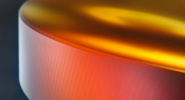
Extremely Large Telescope
Key figures
Background
In 2006, the European Southern Observatory (ESO) started the ELT program with detailed studies for the telescope. Conceived as a ‘window into distant galaxies’, the gigantic telescope depends on a series of five mirrors producing exceptionally accurate high-resolution images from millions of light-years out in space. The ESO looked to SCHOTT’s unrivalled expertise in glass-ceramics, and in 2017 commissioned the company to begin manufacturing of the mirror substrates required to achieve its unprecedented telescopic range.

Task
The ELT project is one of the largest SCHOTT ZERODUR® has ever been involved with, producing the substrate for a total of four glass-ceramic mirrors. Two have a diameter of approx. 4 m, with the secondary mirror (M2) as the largest convex monolithic glass components. The production of the secondary mirror, with a diameter of 4.25 m, is a huge challenge, requiring the grinding of raw material down to just 10 cm or 3.94 inches in thickness. For the primary mirror, SCHOTT has the task of manufacturing 949 mirror segment blanks 1.5 m in diameter at the rate of one per day, each with exactly the same dimensions and properties.Solution
SCHOTT is ideally prepared for this project with its state-of-the-art equipment: A five-axis CNC competence center enables the manufacturing of ZERODUR® glass-ceramic mirrors up to a size of 4.25 meters in diameter with a precision never achieved before . A second melting tank, installed for ZERODUR®, intends to meet the long-term high demand for the material and to contribute to customers’ success.The optical system of the ELT and the role of ZERODUR®
This diagram (artist's rendering) shows the advanced five-mirror optical system of ESO's Extremely Large Telescope (ELT) and the location of the ZERODUR® mirror substrates. It is based on a giant main mirror that combines 798 hexagons (M1) and four smaller mirrors (M2 to M5) as reflectors. The main mirror collects light from the night sky and reflects it onto the M2, at four meters in diameter. This in turn reflects the light to a reflector (M3). The task of this third mirror is to irradiate the light onto the adaptive optics mirror (M4), which changes its surface a thousand times a second to correct the starlight distorted by the earth atmosphere in the telescope build-in adaptive optic systems. Finally, the light reaches the fifth mirror (M5), which stabilizes the extremely sharp images at the final focal plane compensating lower frequency vibrations of the telescope structure.
Consistent image quality in extreme environments
At the heart of the ELT are the outstanding thermal properties of SCHOTT ZERODUR® glass-ceramic. With an extremely low coefficient of thermal expansion, it can be relied upon to perform consistently and reflect light in a highly precise manner in temperature varying environments. SCHOTT’s ability to manufacture it in a wide range of shapes and sizes has also been crucial to the ELT project.Visualizing the vastness of the universe
The power and scale of the Extremely Large Telescope is simply astonishing. With almost crucial elements of the project being done for the first time, it aims to gather 100 million times more light than the human eye, with images 16 times sharper than those achieved by the Hubble telescope. It will also enable more detailed studies of planets surrounding other stars, along with distant galaxies and supermassive black holes, expanding our knowledge and understanding of the universe.
Used materials & similar products
This unique glass-ceramic was developed by SCHOTT to achieve an extremely low CTE (coefficient of thermal expansion), making it ideal for demanding environments that require highly precise positioning. Its potential to be manufactured in large formats is also vital to the ELT project.An unprecedented challenge that demands true teamwork
The planning and building of the ELT is a massive undertaking and one that requires close cooperation between hundreds of technical experts based all over the world. Simply travelling to the ELT site in the middle of Chile’s Atacama Desert is a logistical challenge, so processing and transporting the massive mirrors and components has pushed SCHOTT and its partners to new levels of dedication and innovation.
Mirror substrate made by
SCHOTT
Shaped, polished and assembled by
Safran-Reosc, France
CESA (Spain) VDL (Netherlands)
Support cells for M2 and M3 mirrors
SENER group (Spain)
Quaternary mirror
AdOptica, INAF (Italy)
Dome construction
ACe consortium (Italy)
ELT project owner
ESO, the European Southern Observatory






